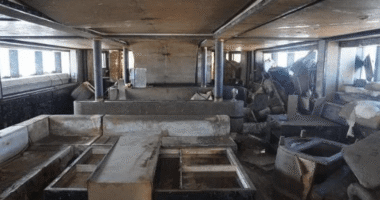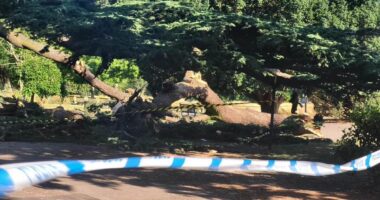
More than 700 people have been injured after a massive explosion at an Iranian port has left at least five people dead.
The blast happened at Shahid Rajaei port which is purportedly linked to a shipment of a chemical ingredient used to make missile propellant.
The incident killed five people while more than 700 were left injured.
It happened as Iran and the US met Saturday in Oman for the third round of negotiations over Tehran’s rapidly advancing nuclear program.
There were no direct claims that the explosion in Iran resulted from an attack. However, Iranian Foreign Minister Abbas Araghchi, who is leading the discussions, communicated on Wednesday that there is a heightened awareness among security services due to previous incidents of attempted sabotage and assassination that were meant to elicit a defensive reaction.
Initially, Iranian authorities did not provide a clear explanation for the explosion at the port near Bandar Abbas. Nonetheless, they confirmed that the incident was unrelated to the nation’s oil industry.
However, the port took in a shipment of ‘sodium perchlorate rocket fuel’ in March, the private security firm Ambrey said.
The fuel is part of a shipment from China by two vessels to Iran first reported in January by the Financial Times.
The fuel involved in the blast was intended to restock Iran’s missile supplies, which had been diminished as a result of its direct engagements with Israel during the conflict with Hamas in the Gaza Strip.
‘The fire was reportedly the result of improper handling of a shipment of solid fuel intended for use in Iranian ballistic missiles,’ Ambrey said.
Ship-tracking data analyzed by The Associated Press put one of the vessels believed to be carrying the chemical in the vicinity in March, as Ambrey said.
Iran hasn’t acknowledged taking the shipment. The Iranian mission to the United Nations didn’t immediately respond to a request for comment on Saturday.
It’s unclear why Iran wouldn’t have moved the chemicals from the port, particularly after the Beirut port blast in 2020.
That explosion, caused by the ignition of hundreds of tons of highly explosive ammonium nitrate, killed more than 200 people and injured more than 6,000 others.
However, Israel did target Iranian missile sites where Tehran uses industrial mixers to create solid fuel.
Social media footage of the explosion on Saturday at Shahid Rajaei saw reddish-hued smoke rising from the fire just before the detonation. That suggests a chemical compound being involved in the blast.
Shahid Rajaei has been a target before. A 2020 cyberattack attributed to Israel targeted the port.
Social media videos showed black billowing smoke after the blast.
Other clips saw reddish-hued smoke rising from the fire just before the detonation. That suggests a chemical compound being involved in the blast.
Others showed glass blown out of buildings kilometers, or miles, away from the epicenter of the explosion.
State media footage showed the injured crowding into at least one hospital, with ambulances arriving as medics rushed one person by on a stretcher.
Mehrdad Hasanzadeh, a provincial disaster management official, told Iranian state television that first responders were trying to reach the area while others were attempting to evacuate the site.
Hasanzadeh said that the blast came from containers at Shahid Rajaei port in the city, without elaborating.
State television also reported that there had been a building collapse caused by the explosion, though no further details were offered.
IRNA news agency said that the Customs Administration of Iran blamed a ‘stockpile of hazardous goods and chemical materials stored in the port area’ for the blast, without elaborating.
The Interior Ministry said that it launched an investigation into the blast.
Shahid Rajaei port in Hormozgan province is about 1,050 kilometers (650 miles) southeast of Iran’s capital, Tehran, on the Strait of Hormuz, the narrow mouth of the Persian Gulf through which 20% of all oil traded passes.
Talks between the US and Iran today over Tehran’s advancing nuclear program ran for several hours today in Muscat.
A person close to Steve Witkoff, the US special envoy to the Middle East, acknowledged that the meeting had started and later ended.
The source spoke on condition of anonymity to discuss the closed-door talks. Iranian state television also reported their conclusion.
However, neither Iranian Foreign Minister Abbas Araghchi nor Witkoff offered any immediate specifics or details on the talks that they’ll lead.
But Omani Foreign Minister Badr al-Busaidi, who has mediated the two previous round of talks in Muscat and Rome, offered a positive note at the end of Saturday’s negotiations.
Iran and the U.S. ‘identified a shared aspiration to reach agreement based on mutual respect and enduring commitments,’ al-Busaidi posted on X.
‘Core principles, objectives and technical concerns were all addressed. Talks will continue next week with a further high level meeting provisionally scheduled for May 3.’
















